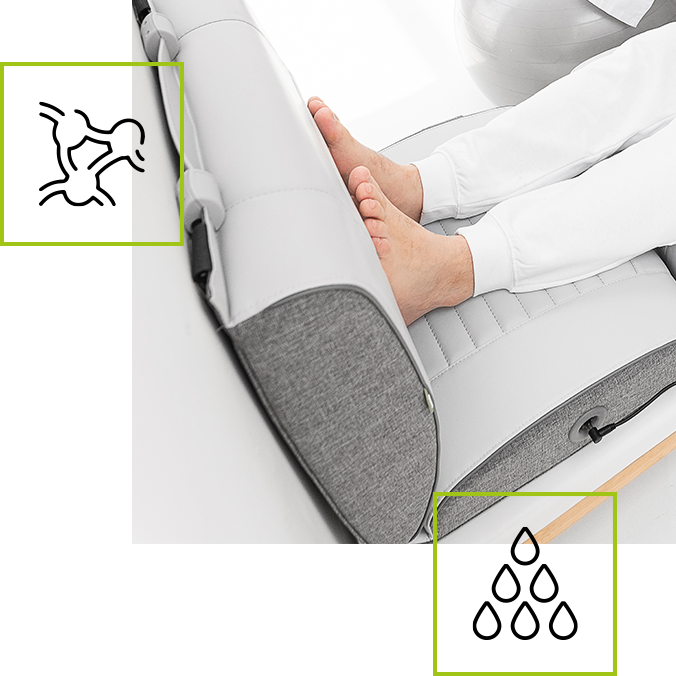Vibrotherapy – an effective method for lymphedema
Vibration with appropriate therapeutic parameters improves the lymphatic system and lymph flow, preventing lymphatic retention and reducing swelling.
How does it work?
Vibration supports the valves of the lymphatic vessels in preventing lymphatic backflow, thus stimulating the muscle pumps that allow lymph to be pushed up the body. Improving lymph flow reduces the formation of stasis and swelling.
.png)

When and for whom?
Lymphedema is most often a complication of cancer treatment or parasitic infections, but can also be linked to genetics and various congenital disorders. We recommend vibrotherapy treatments as a home treatment for lymphedema.
Effectiveness
Vibrotherapy significantly increases the effectiveness of lymphedema treatment, giving satisfactory results after as few as 6 treatments.

Stewart JM, Karman C, Montgomery LD, McLeod KJ. Plantar vibration improves leg fluid flow in perimenopausal women. Am J Physiol Regul Integr Comp Physiol. 2005 Mar;288(3):R623-9
Benefits of vibrotherapy

No side effects

Action confirmed by scientists and practitioners

Perceptible effects from 1 treatment

Long-lasting effects through systematic use
Choose the right product
We will help you select a set of modules that suits your conditions.
Lymphoedema
It is a swelling caused by impaired function of the lymphatic (lymphatic) system. The most important function of this system is defence against infection and recirculation of body fluids. The human circulatory system processes an average of 20 litres of blood per day through capillary filtration. As a result of this filtration, 3 litres of plasma remains in the interstitial fluid of the tissues. It is the lymphatic system that provides a route back into the blood for these 3 litres of plasma. The lymphatic vessels carry the lymph - a tissue-derived fluid similar to plasma but supplemented with elements of the tissues from which it originates - throughout the body, passing through numerous lymph nodes rich in lymphocytes (cells of the immune system), where unwanted materials such as bacteria and damaged cells are filtered out. When lymphatic transport is impaired and swelling develops, there is therefore an increased risk of infection.
Lymphoedema and vibrotherapy
Vibrotherapy is a treatment method that uses vibration or oscillation to improve body function and alleviate various ailments. For the treatment of oedema, vibrotherapy can be used as one of the techniques to assist in the treatment of lymphoedema. Oedema can be caused by the retention of lymphatic fluid or blood in the tissues, leading to the accumulation of fluid between cells. Vibrotherapy can work in several ways in the treatment of oedema.Appropriate vibration stimulates the lymphatic system, which helps to remove excess lymphatic fluids from the swollen areas. This can be particularly beneficial for lymphoedema, where impaired lymphatic outflow is the main cause. Improved blood circulation helps to remove toxins and metabolic waste from the tissues, which can help to reduce swelling.Vibration can help to relax tight muscles and tissues, which can be important for swelling caused by muscle strain or restricted mobility. In addition, vibrotherapy helps to activate muscles that are involved in the drainage of lymphatic fluids. This can be important for oedema resulting from insufficient muscle activity.
Lymphedema - treatment, including home treatment
Although there is no perfect cure for lymphoedema, various therapies can have beneficial effects. The usual therapies used are compression therapy, skin care, exercise (lymph is carried by muscle contractions!) and manual lymphatic drainage, which together are known as combined lymphoedema therapy. More recently, vibrotherapy treatments have also been increasingly recommended, which can be performed by oneself at home using appropriate medical equipment. As a last resort, when other methods do not work, surgical intervention is recommended.
The treatment of oedema depends on the cause and the type of oedema. Here are some general approaches to treating oedema:
- Avoiding causes: If the swelling is the result of a particular condition or disease, treatment should focus on eliminating or controlling that cause. For example, for leg swelling caused by heart failure, treatment may include cardiac medication, diuretics and dietary changes.
- Limb elevation: It is recommended to elevate the swollen limb to facilitate the drainage of lymphatic fluids and blood. For leg swelling, it is important to elevate the legs to heart height whenever possible.
- Use of compression: Wearing elastic bands or compression tights can help minimise swelling by promoting blood and lymphatic fluid circulation.
- Pharmacological treatment: In some cases, especially when the swelling is caused by inflammation, the doctor may prescribe anti-inflammatory drugs or diuretics (diuretics) to increase the excretion of fluid from the body.
- Physiotherapy: physiotherapy exercises can be effective in treating oedema, especially when it is caused by problems with the lymphatic system. A specialist can recommend specific exercises to improve circulation and lymphatic function.
- Dietetics: Dietary changes, such as limiting salt intake, can help control oedema, especially when associated with fluid retention.
- Surgical treatment: In some cases where swelling is caused by lymphatic flow, surgical removal of blockages or repair of lymphatic vessels may be necessary.
- Compression therapy: Specialised therapies, such as pneumatic compression therapy, can be used to increase lymph flow and reduce swelling.





